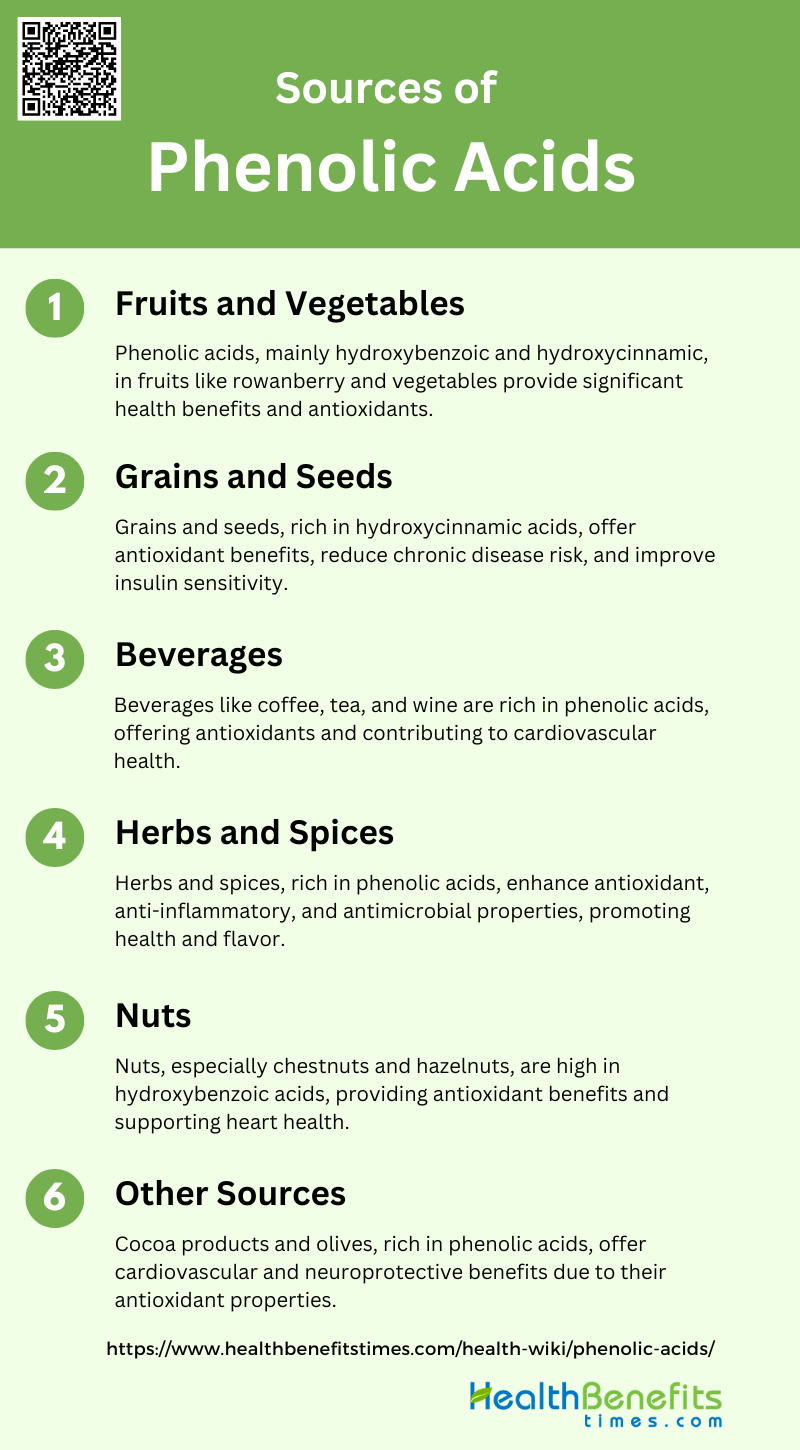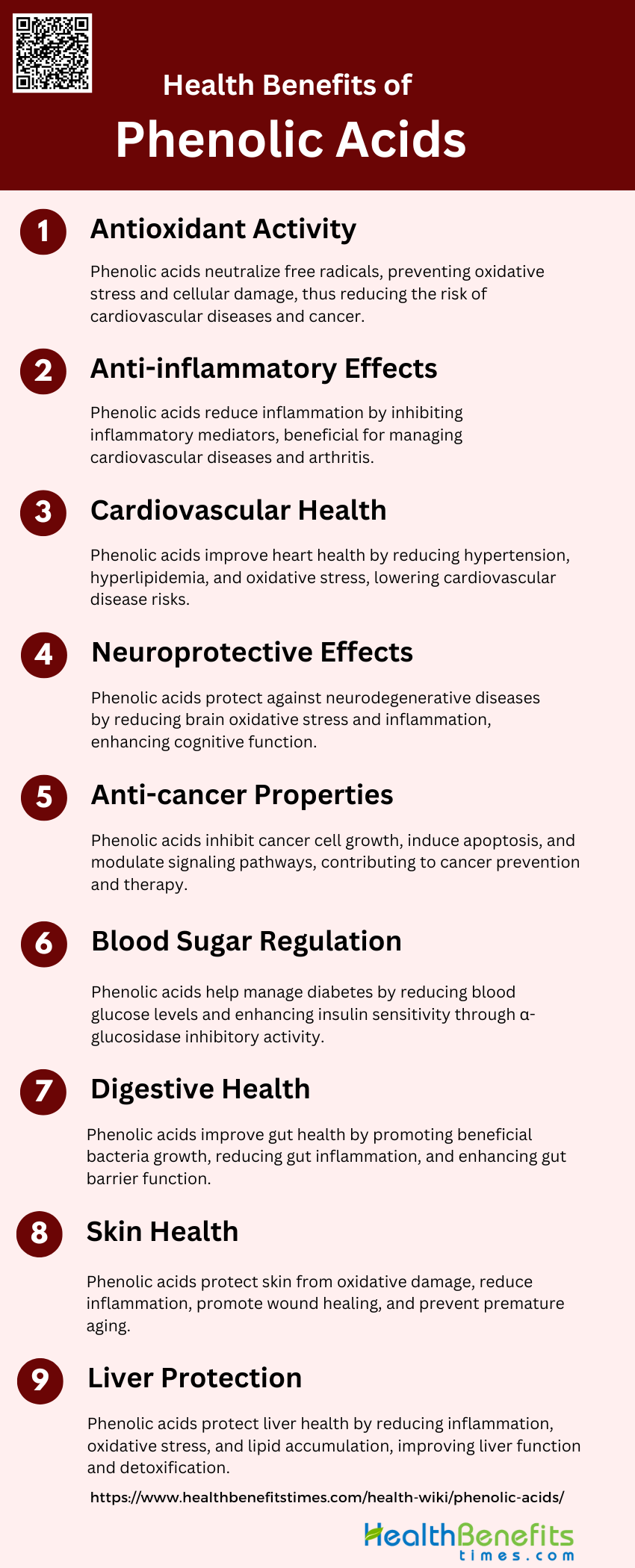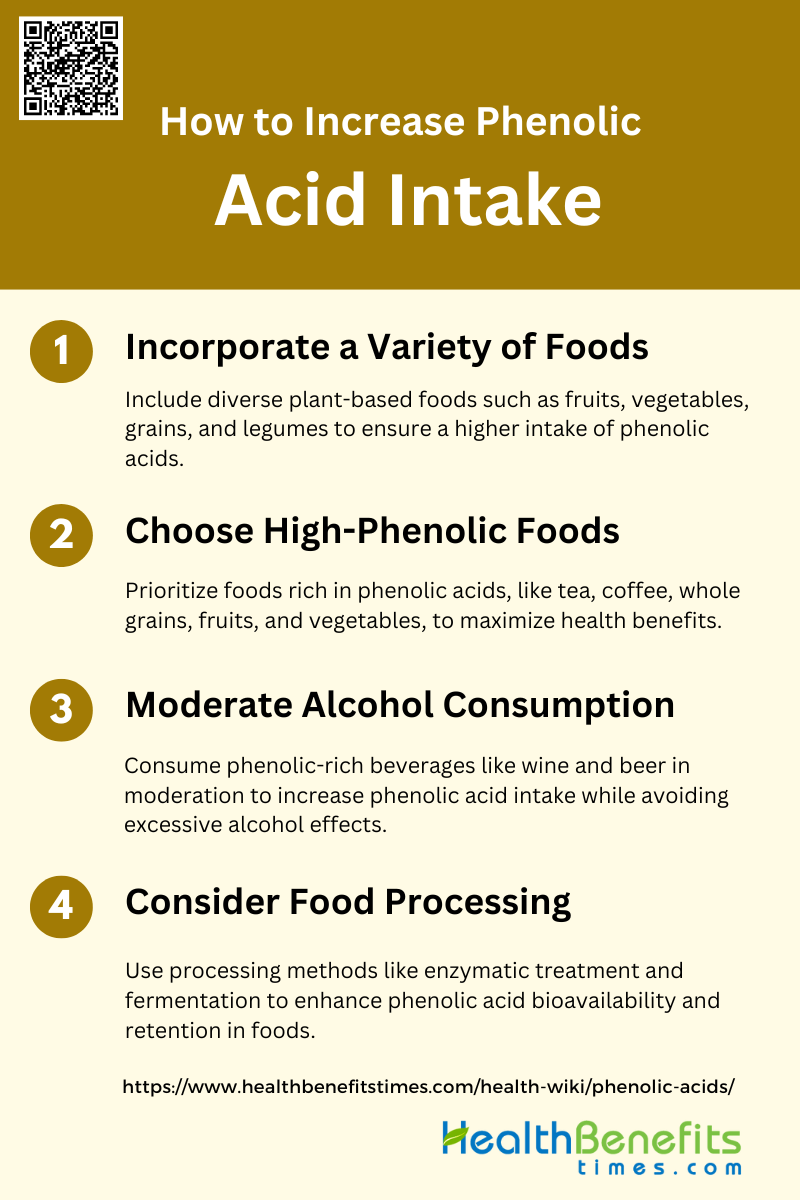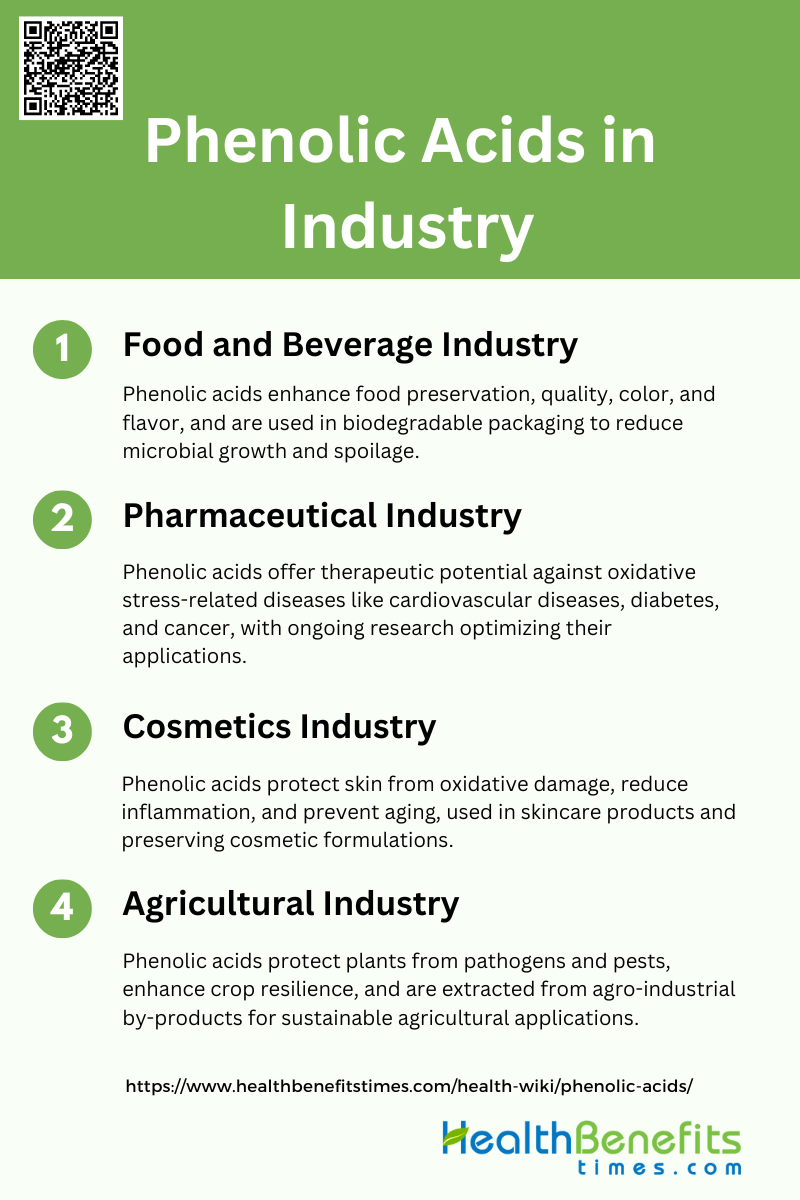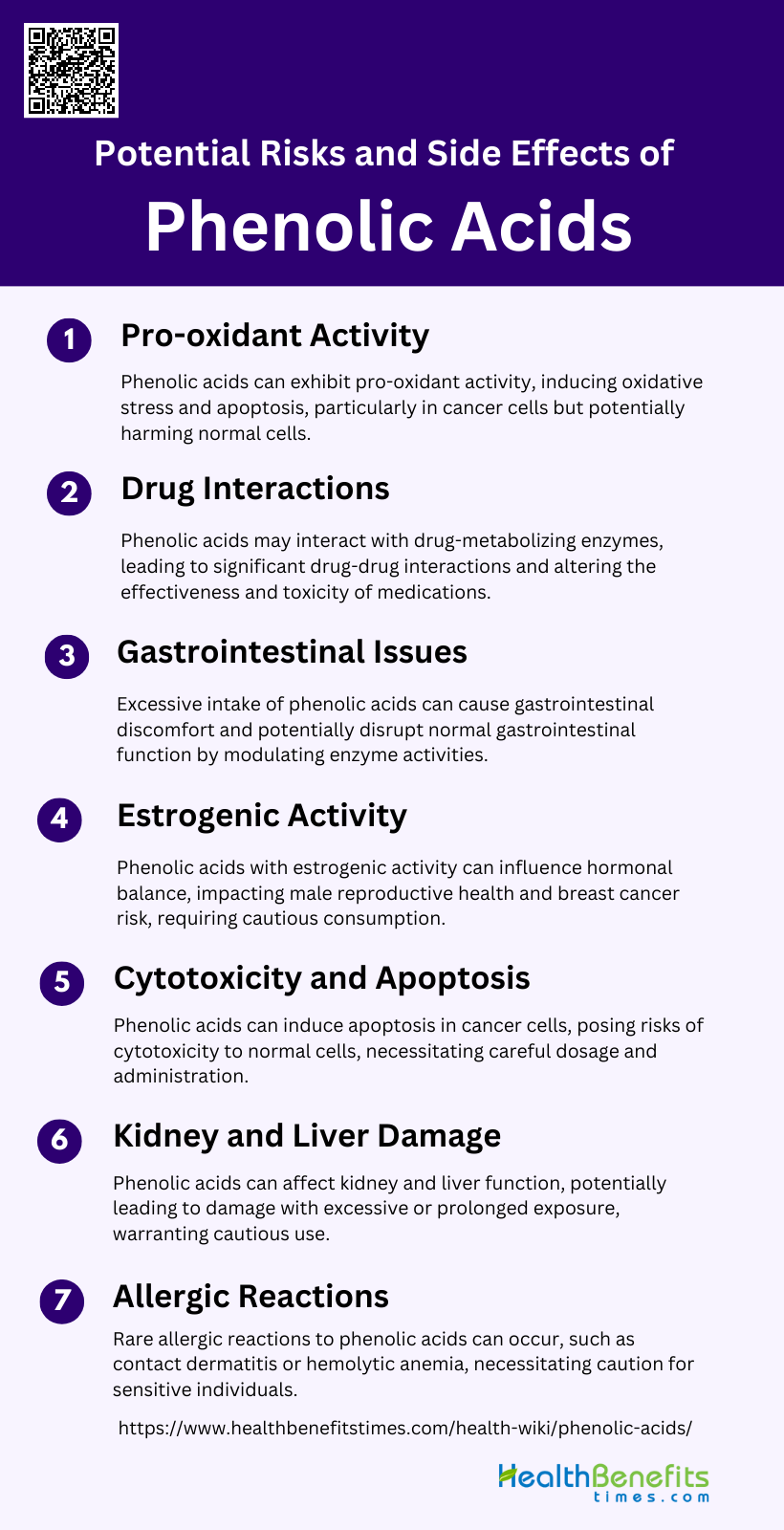Phenolic acids are a class of organic compounds characterized by a phenol ring structure with one or more carboxylic acid groups. These bioactive molecules are widely distributed in plants and are important components of many fruits, vegetables, and herbs. Phenolic acids can be broadly categorized into two main groups: hydroxybenzoic acids and hydroxycinnamic acids. They are known for their potent antioxidant properties, which allow them to neutralize free radicals and reduce oxidative stress in the body. Phenolic acids have gained significant attention in recent years due to their potential health benefits, including neuroprotective effects, anti-inflammatory properties, and possible roles in preventing cognitive decline and various chronic diseases. These compounds are often found in both free and bound forms in plant-based foods and their bioavailability can be influenced by factors such as food processing methods and gut microbiota interactions.
Types of Phenolic Acids
Phenolic acids are a diverse group of plant-based compounds known for their antioxidant properties and health benefits. They are commonly found in a variety of foods, including fruits, vegetables, and whole grains. Below are two notable types of phenolic acids:
1. Hydroxybenzoic Acids
Hydroxybenzoic acids are a class of phenolic acids commonly found in various plants, often in the form of glucosides. These compounds are known for their smaller molecular size, which allows them to incorporate into spaces between polypeptide chains and form hydrogen bonds, leading to aggregation of proteins such as gliadins. Natural sources of hydroxybenzoic acids include fruits, vegetables, and spices. Specific examples of hydroxybenzoic acids are 4-hydroxybenzoic acid, protocatechuic acid, vanillic acid, and syringic acid. These compounds are often conjugated with other natural compounds like flavonoids, alcohols, and sterols, enhancing their functional properties in food plants.
2. Hydroxycinnamic Acids
Hydroxycinnamic acids are another important group of phenolic acids, frequently occurring as simple esters with hydroxy carboxylic acids or glucose. These compounds are larger and stiffer compared to hydroxybenzoic acids, which affects their interaction with proteins, leading to the disaggregation of polypeptide chains. Hydroxycinnamic acids are commonly found in a variety of food plants, including fruits, vegetables, coffee, cereals, oil seeds, and tree nuts. Examples of hydroxycinnamic acids include coumaric acid, caffeic acid, ferulic acid, and sinapic acid. These acids are often bound to cell wall polymers and can be conjugated with other natural compounds, contributing to their diverse roles in plant development and maturation.
Sources of Phenolic Acids
They play a crucial role in plant defense mechanisms and have significant health benefits for humans due to their antioxidant properties. The primary sources of phenolic acids include:
1. Fruits and Vegetables
Phenolic acids are abundant in various fruits and vegetables, contributing significantly to their health benefits. Hydroxybenzoic acids and hydroxycinnamic acids are the primary phenolic acids found in these foods, known for their antioxidant properties. Fruits such as rowanberry, chokeberry, and blueberry are particularly rich in phenolic acids, with contents ranging from 59 to 103 mg/100 g. Vegetables, although often overlooked, are also important sources of phenolic acids. They are consumed in larger quantities compared to fruits and are available year-round, making them a consistent source of these beneficial compounds. The processing methods of vegetables can influence the retention of phenolic acids, and optimal processing techniques are essential to maximize their health benefits.
2. Grains and Seeds
Grains and seeds are notable sources of phenolic acids, particularly hydroxycinnamic acids. These compounds are present in the bran and germ layers of whole grains, contributing to their antioxidant capacity. Flaxseed, for example, is identified as one of the richest sources of polyphenols, including phenolic acids. The consumption of whole grains and seeds is associated with various health benefits, including reduced risk of chronic diseases such as cardiovascular disease and diabetes. The phenolic acids in these foods play a crucial role in modulating carbohydrate metabolism and improving insulin sensitivity. Therefore, incorporating grains and seeds into the diet can be an effective strategy to enhance phenolic acid intake.
3. Beverages
Beverages such as coffee, tea, and wine are significant sources of phenolic acids. Coffee, in particular, is a major contributor, accounting for 55.3-80.7% of total phenolic acid intake in some populations. Green and black teas also contain substantial amounts of phenolic acids, with contents ranging from 30-36 mg/100 g. These beverages are rich in caffeic acid, which is known for its potent antioxidant properties. The regular consumption of phenolic acid-rich beverages has been linked to various health benefits, including improved cardiovascular health and reduced risk of certain cancers. Thus, beverages are an important dietary source of phenolic acids, contributing significantly to overall intake.
4. Herbs and Spices
Herbs and spices are among the richest sources of phenolic acids, despite being consumed in smaller quantities. Cloves, for instance, contain up to 15,000 mg of polyphenols per 100 g, making them one of the most concentrated sources. These compounds contribute to the antioxidant, anti-inflammatory, and antimicrobial properties of herbs and spices. The inclusion of these ingredients in the diet can enhance the flavor and nutritional value of meals, providing a concentrated source of phenolic acids. The high phenolic content in herbs and spices underscores their potential role in promoting health and preventing chronic diseases.
5. Nuts
Nuts are another valuable source of phenolic acids, particularly hydroxybenzoic acids. Chestnuts and hazelnuts are among the nuts with the highest phenolic acid content. These compounds contribute to the antioxidant properties of nuts, which are associated with various health benefits, including reduced inflammation and improved heart health. The regular consumption of nuts can provide a steady intake of phenolic acids, supporting overall health and well-being. The phenolic acids in nuts also play a role in modulating metabolic processes, further highlighting their importance in a balanced diet.
6. Other Sources (Cocoa and Dark Chocolate, Olives)
Cocoa and dark chocolate are rich sources of phenolic acids, particularly flavonoids and proanthocyanidins. These compounds contribute to the antioxidant and anti-inflammatory properties of cocoa products, which are linked to cardiovascular and neuroprotective benefits. Olives and olive oil are also significant sources of phenolic acids, particularly hydroxytyrosol and oleuropein. These compounds are known for their potent antioxidant properties and their role in reducing the risk of chronic diseases. The inclusion of cocoa products and olives in the diet can enhance phenolic acid intake, providing additional health benefits.
Health Benefits of Phenolic Acids
They are known for their potent antioxidant properties, which help combat oxidative stress and reduce the risk of chronic diseases. Some of the key health benefits of phenolic acids include:
1. Antioxidant Activity
These compounds, found abundantly in fruits, vegetables, and cereals, exhibit significant antioxidant capacity as measured by various assays such as DPPH and ABTS radical scavenging activities. The antioxidant activity of phenolic acids is attributed to their ability to donate hydrogen atoms or electrons, thereby stabilizing free radicals and preventing cellular damage. This antioxidant potential is essential in mitigating the risk of chronic diseases such as cardiovascular diseases and cancer.
2. Anti-inflammatory Effects
Phenolic acids possess notable anti-inflammatory properties, which are beneficial in managing and preventing inflammation-related diseases. These compounds, including gallic acid, caffeic acid, and chlorogenic acid, have been shown to reduce pro-inflammatory cytokines and modulate inflammatory pathways. By inhibiting the production of inflammatory mediators, phenolic acids help in reducing the risk of chronic inflammatory conditions such as cardiovascular diseases and arthritis. Their anti-inflammatory effects are crucial in maintaining overall health and preventing the progression of inflammation-related disorders.
3. Cardiovascular Health
These compounds help in reducing hypertension, hyperlipidemia, and atherosclerosis, thereby lowering the risk of cardiovascular diseases. Phenolic acids such as gallic acid and caffeic acid have been shown to improve endothelial function, inhibit platelet aggregation, and reduce oxidative stress, which are critical factors in maintaining cardiovascular health. Their ability to modulate lipid profiles and prevent the oxidation of low-density lipoprotein (LDL) cholesterol further underscores their role in promoting heart health.
4. Neuroprotective Effects
These compounds help in reducing oxidative stress and inflammation in the brain, thereby protecting neuronal cells from damage. Phenolic acids such as rosmarinic acid and ferulic acid have been shown to enhance cognitive function and prevent the accumulation of amyloid-beta plaques, which are associated with Alzheimer’s disease. Their neuroprotective properties are crucial in maintaining brain health and preventing age-related cognitive decline.
5. Anti-cancer Properties
The anti-cancer properties of phenolic acids are well-documented, with these compounds exhibiting the ability to inhibit cancer cell proliferation and induce apoptosis. Phenolic acids such as gallic acid, caffeic acid, and ferulic acid have been shown to target various cancer cell lines and reduce tumor growth. These compounds exert their anti-cancer effects by modulating signaling pathways, inhibiting angiogenesis, and inducing cell cycle arrest. The antioxidant and anti-inflammatory properties of phenolic acids further contribute to their potential in cancer prevention and therapy.
6. Blood Sugar Regulation
These compounds exhibit α-glucosidase inhibitory activity, which helps in reducing postprandial blood glucose levels. Phenolic acids such as gallic acid and caffeic acid have been shown to enhance glucose uptake in cells and improve insulin sensitivity, thereby aiding in blood sugar control. Their antioxidant properties also help in mitigating oxidative stress associated with diabetes, further contributing to their anti-diabetic potential.
7. Digestive Health
Phenolic acids contribute to digestive health by modulating gut microbiota and enhancing gut barrier function. These compounds help in promoting the growth of beneficial bacteria and inhibiting pathogenic bacteria, thereby maintaining a healthy gut microbiome. Phenolic acids also exhibit anti-inflammatory properties that help in reducing gut inflammation and preventing gastrointestinal disorders. Their role in improving gut health is crucial in maintaining overall digestive function and preventing diseases such as nonalcoholic fatty liver disease (NAFLD).
8. Skin Health
These compounds help in protecting the skin from oxidative damage caused by UV radiation and environmental pollutants. Phenolic acids such as gallic acid and ferulic acid have been shown to reduce skin inflammation, promote wound healing, and prevent premature aging. Their ability to modulate collagen synthesis and protect against photoaging further underscores their role in maintaining healthy skin.
9. Liver Protection
Phenolic acids exhibit hepatoprotective properties, which are essential in preventing liver diseases such as nonalcoholic fatty liver disease (NAFLD). These compounds help in reducing liver inflammation, oxidative stress, and lipid accumulation, thereby protecting liver function. Phenolic acids such as caffeic acid and ferulic acid have been shown to improve liver enzyme levels and enhance detoxification processes. Their role in modulating gut microbiota also contributes to their liver-protective effects, making them beneficial in maintaining liver health.
How to Increase Phenolic Acid Intake
Boosting your intake of phenolic acids can be easily achieved by making mindful dietary choices. These beneficial compounds are abundant in a variety of plant-based foods, including fruits, vegetables, and whole grains. To enhance your phenolic acid consumption, consider the following strategies:
1. Incorporate a Variety of Foods
To increase phenolic acid intake, it is essential to incorporate a variety of foods into your diet. Phenolic acids are abundant in a wide range of plant-based foods, including fruits, vegetables, grains, and legumes. For instance, rice, tea, and fruits are significant contributors to dietary phenolic acid intake in various regions. Vegetables, although often overlooked, are also a valuable source of phenolic acids and can be consumed year-round. By diversifying your diet to include a broad spectrum of these foods, you can ensure a higher intake of phenolic acids, which are linked to numerous health benefits, such as reduced risk of non-alcoholic fatty liver disease and insulin resistance.
2. Choose High-Phenolic Foods
Selecting foods that are particularly high in phenolic acids can significantly boost your intake. Beverages like tea and coffee are among the richest sources of phenolic acids, with coffee alone accounting for a substantial portion of phenolic acid intake in many populations. Additionally, whole grains, especially those processed to release bound phenolic acids, can enhance bioavailability and contribute to higher phenolic acid levels in the body. Fruits and vegetables, particularly those rich in hydroxycinnamic and hydroxybenzoic acids, should also be prioritized. By focusing on these high-phenolic foods, you can maximize the health benefits associated with phenolic acid consumption.
3. Moderate Alcohol Consumption
Moderate alcohol consumption, particularly of phenolic-rich beverages like wine and beer, can also contribute to phenolic acid intake. Studies have shown that beer, for example, is significantly inversely associated with hypertension due to its phenolic acid content. However, it is crucial to consume these beverages in moderation to avoid the adverse effects of excessive alcohol intake. The phenolic acids in these beverages can provide additional health benefits, such as improved vascular function and reduced risk of cognitive decline. Therefore, moderate consumption of phenolic-rich alcoholic beverages can be a strategic addition to a diet aimed at increasing phenolic acid intake.
4. Consider Food Processing
Food processing methods can significantly impact the phenolic acid content of foods. For example, enzymatic processing of whole grains can release bound phenolic acids, making them more bioavailable and enhancing their health benefits. Similarly, certain pre-treatments and storage conditions can help retain higher levels of phenolic acids in vegetables. Fermentation with specific probiotic strains has also been shown to increase the free phenolic acid content in grains, further improving their bioavailability. By considering these processing techniques, you can optimize the phenolic acid content of your diet and enhance the associated health benefits.
Phenolic Acids in industry
These compounds are essential in the production of food additives, pharmaceuticals, and cosmetics. Key industrial uses of phenolic acids include:
1. Food and Beverage Industry
Phenolic acids play a significant role in the food and beverage industry due to their antioxidant and antimicrobial properties. They are widely present in fruits, vegetables, and beverages such as coffee and tea, contributing to the organoleptic properties and overall quality of these products. The incorporation of phenolic acids into biodegradable food packaging materials has been explored to enhance food preservation by reducing microbial growth and oxidative spoilage. Additionally, phenolic acids are involved in the color and flavor of various food products, such as red fruits, juices, and wines, making them essential for maintaining the sensory attributes of these items.
2. Pharmaceutical Industry
In the pharmaceutical industry, phenolic acids are recognized for their therapeutic potential due to their antioxidant, anti-inflammatory, and antimicrobial properties. These compounds are being investigated for their ability to protect against oxidative stress-related diseases, including cardiovascular diseases, diabetes, and cancer. Phenolic acids such as caffeic and p-coumaric acids have shown promising results in inhibiting enzymes like alpha-glucosidase and lipase, which are targets for managing diabetes and obesity. Their bioavailability and metabolism are crucial for understanding their health-promoting properties, and ongoing research aims to optimize their therapeutic applications.
3. Cosmetics Industry
The cosmetics industry utilizes phenolic acids for their antioxidant and anti-aging properties. These compounds help protect the skin from oxidative damage caused by environmental factors such as UV radiation and pollution. Phenolic acids are incorporated into skincare products to enhance skin health, reduce inflammation, and prevent the formation of wrinkles and fine lines. Their ability to inhibit microbial growth also makes them valuable in preserving cosmetic formulations and extending their shelf life. The ongoing research into the bioavailability and stability of phenolic acids in cosmetic products aims to maximize their efficacy and benefits.
4. Agricultural Industry
In the agricultural industry, phenolic acids are explored for their role in plant growth, development, and defense mechanisms. They are involved in protecting plants against pathogens and pests, making them valuable for developing natural pesticides and enhancing crop resilience. The extraction of phenolic acids from agro-food industrial by-products offers a sustainable approach to valorize waste materials and produce bioactive compounds for agricultural applications. Additionally, phenolic acids can be used to improve the nutritional quality of animal feed and promote animal health, contributing to more sustainable and efficient agricultural practices.
Potential Risks and Side Effects of Phenolic acids
While phenolic acids are known for their beneficial properties, excessive intake or sensitivity to these compounds can lead to adverse effects. It is important to be aware of potential risks and side effects to ensure safe consumption. Some of the common risks and side effects include:
1. Pro-oxidant Activity
This dual behavior is particularly evident in cancer cells, where phenolic acids can induce oxidative stress, leading to apoptosis. For instance, caffeic acid has been shown to act as a chain-breaking antioxidant in membrane models but can also induce oxidative stress in cultured cells, leading to apoptosis in leukemia cells. This pro-oxidant activity is a double-edged sword, as it can be beneficial in targeting cancer cells but may also pose risks to normal cells if not carefully controlled.
2. Drug Interactions
Phenolic acids can interact with various drug-metabolizing enzymes and transporters, potentially leading to significant drug-drug interactions (DDIs). For example, gallic acid and gentisic acid have been shown to inhibit human organic anion transporters (hOAT1 and hOAT3), which are crucial for the renal excretion of many drugs. This inhibition can alter the pharmacokinetics of concomitant medications, potentially leading to increased toxicity or reduced efficacy. Such interactions highlight the need for careful consideration when phenolic acids are consumed alongside other medications.
3. Gastrointestinal Issues
Phenolic acids can also impact gastrointestinal health. While they possess antioxidant and anti-inflammatory properties, excessive intake can lead to gastrointestinal discomfort and other issues. For instance, phenolic acids like gallic acid and syringic acid have been shown to modulate antioxidant enzyme activities in the liver and small intestine, which could potentially disrupt normal gastrointestinal function if consumed in large amounts. Additionally, their role in modulating gut microbiota and intestinal barrier function warrants further investigation to fully understand their impact on gastrointestinal health.
4. Estrogenic Activity
Some phenolic acids exhibit estrogenic activity, which can have both beneficial and adverse effects. For example, flavonoids and other dietary phenolics, including isoflavones, have been associated with estrogenic effects that could influence male reproductive health and breast cancer risk. These compounds can mimic or interfere with the action of endogenous estrogens, potentially leading to hormonal imbalances. While this estrogenic activity can be beneficial in certain contexts, such as in the prevention of osteoporosis, it also raises concerns about the long-term safety of high phenolic acid intake.
5. Cytotoxicity and Apoptosis
Phenolic acids have demonstrated cytotoxic and pro-apoptotic effects, particularly in cancer cells. Studies have shown that phenolic acids like caffeic and gallic acid can induce apoptosis in various cancer cell lines, including leukemia and adenocarcinomas. This cytotoxicity is often mediated through the induction of oxidative stress and the activation of apoptotic pathways. While these properties make phenolic acids promising candidates for cancer therapy, they also pose risks of cytotoxicity to normal cells, necessitating careful dosage and administration.
6. Kidney and Liver Damage
Phenolic acids can also impact kidney and liver function. For instance, the administration of phenolic acids in rats has been shown to modulate the activities of hepatic antioxidant enzymes and alter oxidative status in the liver. While these effects can be protective against oxidative damage, excessive or prolonged exposure to phenolic acids could potentially lead to liver and kidney damage. The upregulation of multidrug resistance-associated proteins and changes in glutathione levels further underscore the need for caution in the use of phenolic acids.
7. Allergic Reactions
Allergic reactions to phenolic acids, though relatively rare, can occur. These reactions may manifest as contact dermatitis, hemolytic anemia, or other hypersensitivity responses. The potential for allergic reactions is particularly concerning given the widespread use of phenolic acids in dietary supplements and herbal medicines. Individuals with known sensitivities to phenolic compounds should exercise caution and consult healthcare providers before consuming products containing high levels of phenolic acids.



